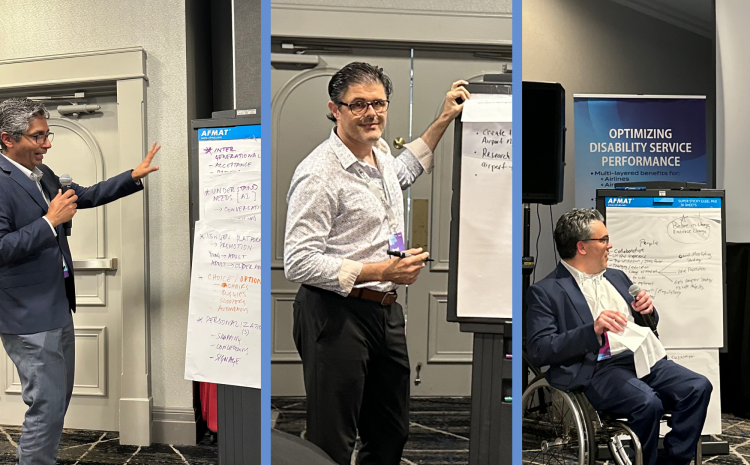
2025 Airport PRM Leadership Conference Whiteboard Highlights: Rethinking Accessibility
At the 2025 Airport Accessibility Leadership Conference, professionals from across aviation, accessibility, and technology came together to explore how the industry can move beyond baseline compliance to create services that are more inclusive, responsive, and future-ready.
Through three collaborative whiteboard sessions, participants tackled the challenges and opportunities facing accessibility services today. Each session was guided by a central question and facilitated by an industry leader with practical experience. Together, the discussions reflected a collective commitment to rethinking not just what accessibility looks like, but how it feels and how it can better serve the needs of all travelers.
1. “Generational change fuels the request for greater independence. How can the industry embrace and respond to this new trend?”
Facilitated by Rajeev Ramanath, Founder & CEO, Blueberry Technology
This session addressed how the aviation industry can adapt to changing societal dynamics by rethinking how accessibility services are designed and delivered across generations.
Facilitator Rajeev Ramanath guided a conversation that highlighted the importance of acknowledging generational diversity, not just in age, but in expectations, communication styles, and comfort with technology. Participants emphasized that as expectations evolve, so too must service models. The group encouraged a shift from rigid, standardized solutions to more adaptive ones that prioritize empathy, autonomy, and relevance.
Rather than a one-size-fits-all approach, attendees advocated for services that offer real choice, such as buggies, scooters, autonomous mobility, or traditional assistance, allowing each traveler to determine what best suits their needs. They also discussed the role of personalization in enhancing the overall passenger journey, particularly across shopping, concessions, and signage.
Promoting awareness and understanding across age groups was another key point, whether through top-down education campaigns, influencers, or family-based storytelling. Multi-channel delivery, ensuring that messaging, booking, and support tools are accessible across digital and human touchpoints, was seen as vital to serving a broad range of users effectively.
Finally, while AI was mentioned in the context of understanding user needs, the emphasis was not on complex automation but on simple tools that help staff and systems better recognize and adapt to different user personas and preferences. At the heart of the discussion was a call to embrace change with empathy, curiosity, and flexibility, building systems that work not just for one kind of traveler, but for everyone.
2. “What can the industry do to outperform the existing regulatory frameworks and support lawmakers in drafting better rules?”
Facilitated by Darrell Watson, Senior VP & Chief Experience Officer, Louisville Regional Airport Authority
This session focused on how the aviation industry can move beyond compliance by setting the pace for accessibility standards and actively influencing future regulation.
Darrell Watson guided a discussion that underscored the importance of consistent, coordinated leadership across all airport actors, from management to third-party tenants. The group proposed the creation of a structured training framework, applied annually across all airport stakeholders, to ensure a shared understanding of accessibility and service expectations at every level.
Participants called for broader research into passenger needs, especially those that arise beyond the physical airport footprint. This included evaluating touchpoints before and after the journey, as well as considering more diverse user profiles when designing services and environments.
The session also highlighted the need for consistent communication standards across airport websites, updated aircraft design guidelines, and improved checklists to close gaps in user experience. These are not simply operational fixes, but they represent opportunities to deliver on accessibility in tangible, meaningful ways.
A key theme was industry collaboration. Attendees pointed to the value of aligning major organizations, such as ACI, AAAE, ACT, ICAO, and the disability community, to develop a global framework that unifies best practices and encourages governments to adopt stronger, more relevant legislation.
At its core, this session emphasized a shift in mindset: from minimum compliance to passenger rights and dignity as a central operating principle. As one participant noted, the customer must be at the center, not just in policy, but in every decision that touches their journey.
3. “How can technology fast-track innovation in the framework of assisted travel?”
Facilitated by Brett Heising, Accessibility Expert and Inclusive Innovation Advocate
Participants explored how innovation in accessibility services can succeed when the right conditions are in place, not just the right technologies. Brett Heising emphasized that fast-tracking innovation might start with technology, but at the end of the day, this really depends on people being ready and willing to embrace change. This includes not only travelers, but also airport staff, service providers, and regulatory bodies.
The group identified several enablers for successful adoption: training and education to reduce fear of the unknown, intuitive design that minimizes stress, and a clear value proposition that resonates with both early and late adopters. A unified user experience, strong collaboration across stakeholders, and governmental support were also seen as essential.
At the heart of it all is people. As Brett underscored, innovation in accessibility is not simply about deploying tools, it’s about how individuals experience, engage with, and trust those tools. Technology can open doors, but it is people, travelers, staff, and leadership, who determine whether innovation delivers lasting impact.
A Path Forward
While each session addressed a distinct question, several themes consistently emerged: the need for more flexible systems, stronger collaboration, smarter use of technology, and a more holistic understanding of what passengers actually experience and need.
Accessibility is no longer just about getting from A to B. It’s about doing so with confidence, clarity, and comfort. That means building services that are timely, respectful, and empowering, designed to reflect the dignity and autonomy every traveler deserves.
The 2025 Airport Accessibility Leadership Conference made clear that the future of accessibility lies in systems that are thoughtful by design and led by those closest to the passenger experience. With the right tools, mindset, and cross-sector commitment, the industry can ensure that accessibility is not an afterthought, but a defining standard of quality and care.


